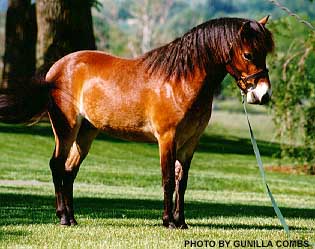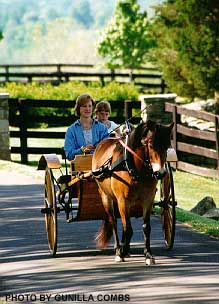

Gotland


Introduction: If you have any comments or suggestions, please click here. Much of the information on this page is taken directly from Kokovoko, a stronghold of Gotland breeding. Please see their website also, at www.gotlands.net. I also got information from a brochure put out by the Gotland Russ Association of North America (GRANA). You can visit their website at www.gotlandponies.org.
Names: Gotland, Gotland/Russ. I have found this breed identified as the Gotland, the Russ, or both, but usually as the Gotland. I will consider them the same for now, and for now will refer to it by whichever name is used in the source I am getting information from. I have also heard this called the Skogsruss; I assume this is the Swedish name for it. (It seems that they are called Russ by the locals and the Gotland Pony by others, to indicate where they are from, but as I am only guessing, I will leave it as above for now.) Sometimes it is also called the Viking pony.
Origin: Lives
on the Island of Gotland in Sweden. Some years ago,
excavations in a Gotland cave produced skeletons of a Stone Age pony--the
forebears of this breed. Originally all the ponies ran wild and untended
in the forests, as indicated by their other name, Skogsbagge, which means
"small
ram dwelling in the woods," but today only a portion live semi-wild on a moor
called Logsta Hed. About the beginning of the 19th century, the ponies
were exported in large numbers to England,
Germany
and Belgium, for work in the
mines, and the breed was saved only by the efforts of the Gotland Pony Club and
interested farmers.
(I put this in before I began citing the dates for my
sources, so I don't really know when "today" was. I imagine it
was in the 1970's or 80's.)
Breeding areas and studs--Sweden: Stud on the island of
Gotland, otherwise breeding almost exclusively in hands of farmers.
These are small, attractive ponies of a uniform type produced of late years by selective
breeding.
(The following is taken from another source--this time the
brochure by GRANA.) In Sweden, on the island of Gotland in the Baltic Sea,
lives a herd of semi-wild horses, the Gotland Pony or "Russ" as they
are called locally. The breed has lived in isolation and has kept its
moderate size and attractive looks since the Stone Age.
There have been wild horses on the island of Gotland for at
least 4000-5000 years, but nobody knows for sure where they came from.
Findings from about 3,000 BC show that the horses were kept in a semi-domestic
fashion, being used primarily for food but also for various chores. It is
widely believed that Gotlands are descendants of the wild Forest Ponies which
roamed Central Europe, and has ties back to the ancient Tarpan.
In the beginning of the 19th century, the Russ could be found
throughout Gotland, but when the formerly public land was divided up between
farmers, the Russes were caught and many were sold, even exported to coal-mines
in Belgium and England, and to Germany to be used, for example, to pull
milk-carts.
The Russ' popularity, because of its many uses, its strength
in relation to its handy size (11.2-13 hands) and being easy to keep, almost
caused the Russ to become extinct. Around 1880 there were bout 11,500 Russ
on Gotland - in 1930 only 30 brood-mares were active. After this low
period, the Russ have been on a steady rise. Planned breeding, and vivid
cooperation between breeders on Gotland and mainland Sweden shaped the strong
breed we see today.
A herd of about 80 Russ is still kept on the moor of Lojsta
in the southern part of Gotland, where they roam three different pastures totalling
240 acres. They are owned by local farmers and breeders as well as the
Gotland Agricultural Society, which cares for and keeps record of the
herd. The Russ live in freedom and are only rounded up a few times yearly;
twice a year for hoof trims, when the stallion is let out to join the herd in
June, for judging in July, and in November when the foals are separated from the
mares. In winter they get supplementary feeding every other day and a care
taker visits the herd daily to ensure its well-being.
Breeding: According
to one source, they
have little "outside" blood, although a Syrian and an Oriental stallion were
introduced about a hundred years ago; however, another source has claimed that,
although this is an ancient indigenous breed, there has been frequent admixture of outside
blood over the centuries.
Gotlands lived for thousands of years in the forests of their
Baltic island with little help from humans. They are believed to be direct
descendants of the ancient Tarpan,
and their history is mingled with the lively legends of Vikings, czars, and
warrior kings. Humans found these reliable horses invaluable for battle,
transportation, mining, and draft work.
But in the mid-1800s humans began settling and dividing the
native forest that was the Gotlands' habitat. By the early 20th century,
only about 150 Gotlands survived. Meat rationing and food shortages of
World War I led poachers to hunt the Gotlands until they were near extinction.
It was then that a handful of Gotland farmers got together to
fence in a 200 acre pasture for the few remaining horses, allowing them to run
and live free.
Gotlands were first imported to the U.S. in 1957. They
became quite popular, and their numbers grew into the hundreds until a tragic
combination of human circumstances almost eradicated them from the continent.
In 1989, with less than ten known Gotlands scattered across
North America, the last of the remaining herd of mares and a stallion were taken
to Kokovoko, in Corinth, Kentucky. The Gotland Revival had begun.
Since then, several importations have brought more wonderful Gotland ponies (and
bloodlines) to the U.S.
Once on the brink of extinction, these legendary, ancient
forest horses are back, strong, and ready for riding, driving, racing, and work,
for children and adults.
This is still a rare breed in North America, though its
numbers have increased dramatically in the last fifteen years--there are now 200
of them.
A small, ancient breed, native to the island of Gotland in
the Baltic Sea off the mainland of Sweden. Believed to be directly
descended from forest-dwelling ponies that used to inhabit north-central Europe
(the so-called Forest Type of the original horse types, I believe). These
ponies are now being bred also in the U.S. and Alberta, Canada, as well as in
Gotland and Sweden.
Description: Most of the following description is of the Swedish Gotland, as described by Kokovoko (see above).
Action: Walk and trot industrious and eager. Good galloping ability. Able to jump. Movement is smooth and elastic at all gaits. The trot is their strength, and they can keep it up for days.
Body: Breast and chest are deep, providing room for excellent wind capacity. Shoulder is long and sloping, joining well-defined withers. The back is well muscled and strong, with a rounded croup and well-carried tail. (One source indicated thin neck, relatively steep shoulders, frequently rather weak back, and sloping croup and quarters with low-set tail. I am inclined to believe that this latter description may fit the wild, perhaps less well bred Gotland, while the former is probably indicative of the typical domestic Gotland.)
Color: All colors except albinos, grays and roans, but often brown, bay or chestnut, usually with dark legs and light coloring around the eyes and muzzle. Black, bay, sorrel, or dun.
Hair: Mane and tail are full, fetlock feather light. Wooly bears in winter, they shed out sleek in summer. In winter, the hair-coat grows to about 3 inches long.
Head: Long and extended, with small ears and bright eyes. Straight or dished profile, with a broad forehead; shapely muzzle; large nostrils; large, wide-set, expressive eyes; and a deep round jaw.
Hooves: Round and so exceptionally tough and hard that shoes are optional.
Legs: Forearms and gaskins are muscular, and all tendons and joints are clean and strong. The cannon bone is fine but very dense. Pasterns are sloping and flexible. (Again, I had one source that stated front legs are often misplaced, and hind legs cow hocked, with weak, yet untiring joints and tendons. As before, I am inclined to believe that the latter is descriptive of the old, wild Gotland, while the former is the better bred, domestic Gotland.)
Size: About 12-13 hands. Conformation and way of going are of a light horse type. They're larger than a Shetland and a bit stockier than a Hackney, averaging 600-700 pounds. The GRANA sets the height at 11.2 (or 11.3) to 13 hands. 45-51 inches.
Temperament: Good. Excellent character, fiery temperament. Disposition is their hallmark. They are loveable, smart, predictable, willing, sane, and a pleasure to train. Energetic, intelligent, and friendly.
Features: Medium-sized, originally half-wild pony, able to live economically. Energetic, of iron constitution and stamina. A favourite children's pony. No small breed matches the rare versatility, intelligence, and unflappable disposition of the warm-blooded Gotland. They are manageable for children, and they are strong and smart enough for the most experienced adult riders. Their size enables a child to learn good horsemanship without outgrowing the horse. Primitive looks and natural hardiness. They carry average adults easily and pull good loads. Resilient, healthy and long-lived. It is not unusual for Gotlands to be sound well into their thirties.
Uses: Good
trotter and jumper. Many are domesticated and in demand as
children's ponies. In Sweden Gotlands reap great success in the show ring,
in all disciplines: three-day eventing, show jumping, dressage, driving and
harness racing. Indeed, in its home country, the Gotland has turned youth
harness racing into a national passion. The Russ holds the world record
for harness racing for ponies in category B. In America, they show natural
ability for Western and English pleasure, jumping, dressage, pleasure and
combined driving, barrel racing, endurance, and just plain trail riding (or even
vaulting).
There are also Gotland sport ponies--the strength,
disposition and sanity of a Gotland with some added size (up to 14.2
hands). These ponies are also registerable as half-Gotlands, and have some
great athletes in their heritage--from Welsh
to Thoroughbred.
Accomplishments:
Curiosities: There is also an American Gotland Pony, bred in the U.S. from ponies imported from the Baltic island of Gotland. According to one source they are 45-51 inches tall; colored black, grey, sorrel, or dun; and used for children's mounts and as a pony-sized racing trotter (really very little different from the original Gotland).
Profiles:
Conclusion: